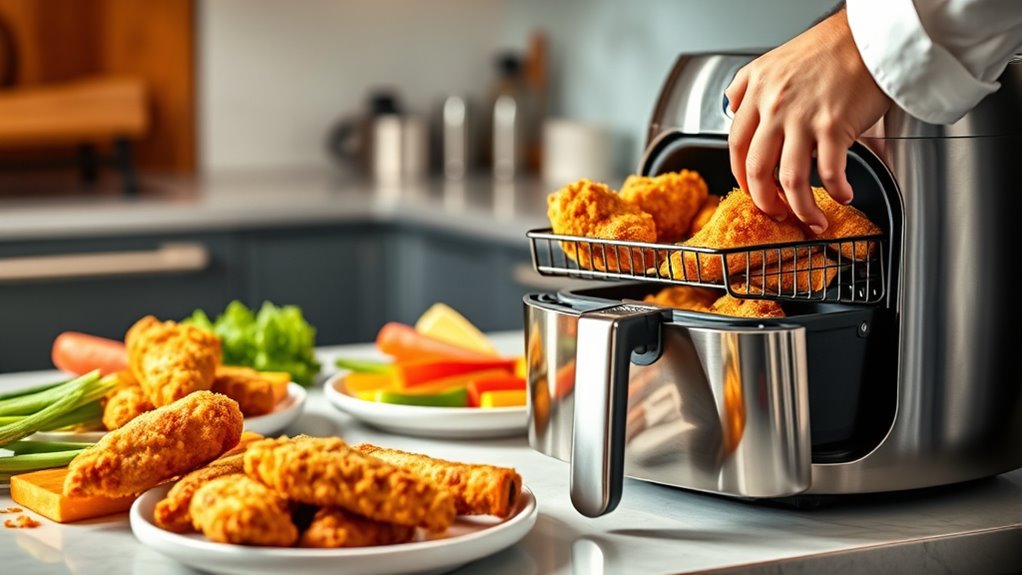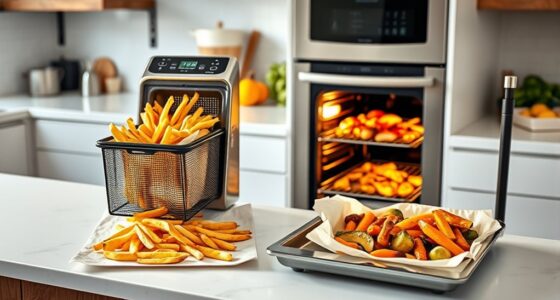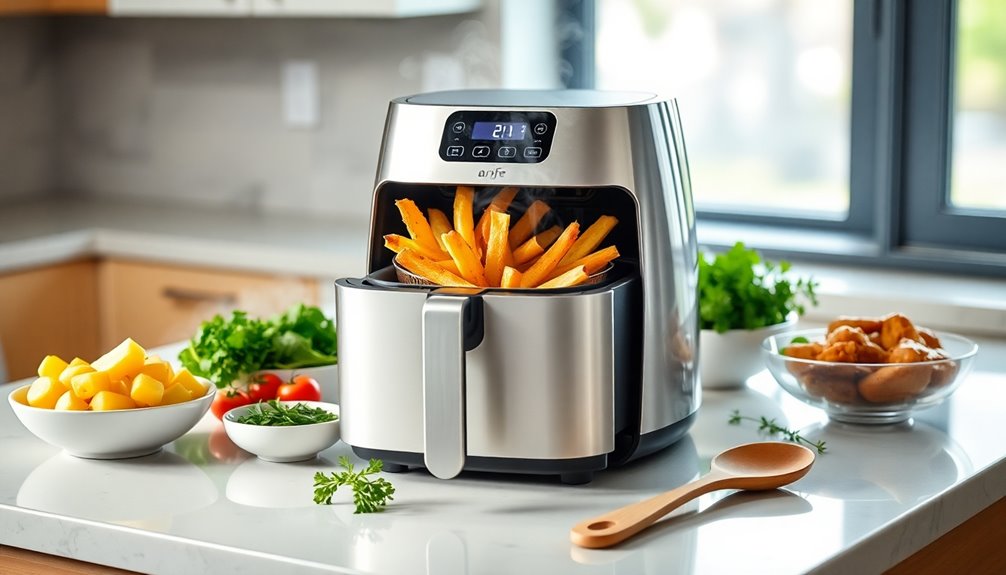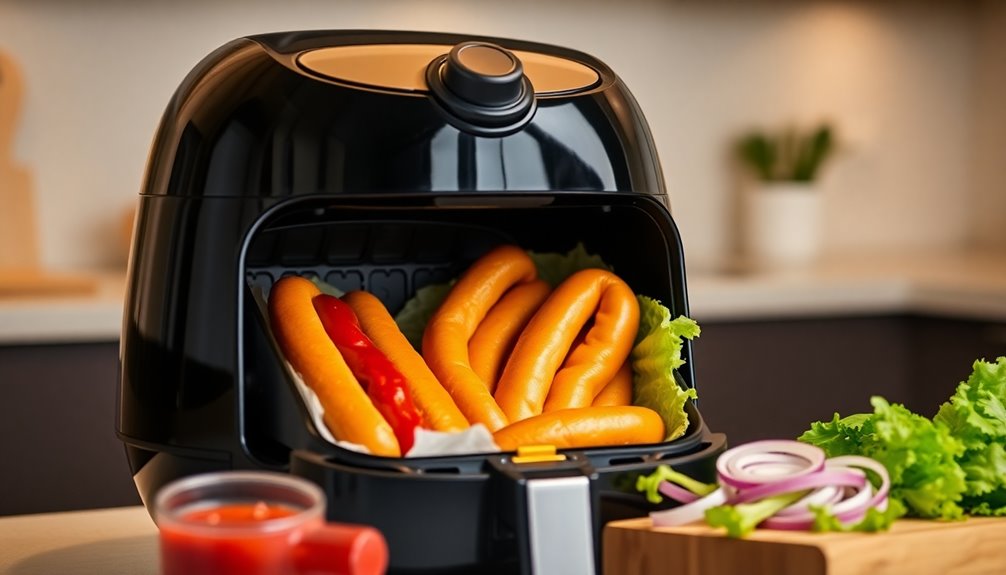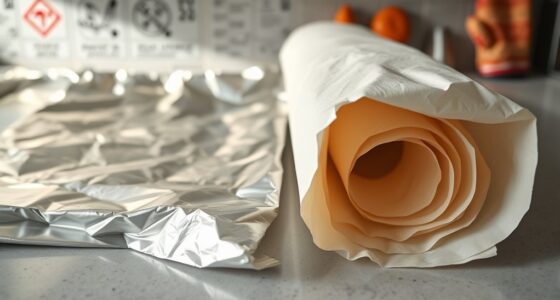To convert your favorite recipes for air frying, first identify how the dish was cooked originally. Adjust the temperature down by about 25°F and reduce cooking time by 20-25%. Prep ingredients evenly and use a light oil or egg wash to help breadings stick. Monitor the food closely and flip or shake halfway through. For ideal results, experiment with seasoning and accessories. Keep exploring tips to perfect your air frying skills and achieve delicious results.
Key Takeaways
- Reduce the original cooking temperature by about 25°F (14°C) and decrease cooking time by 20-25%.
- Cut ingredients into uniform pieces and pat dry for even cooking and crispiness.
- Use appropriate cookware like perforated baskets or silicone liners to ensure proper airflow.
- Check food early and often, using a thermometer for meats to ensure safety and doneness.
- Adjust seasonings and coatings to prevent sogginess and enhance flavor during rapid air frying.
Assess the Original Recipe’s Cooking Method and Temperature

Before converting a recipe for air frying, it’s essential to understand how it was originally cooked. Check the cooking method—whether it was baked, fried, grilled, or roasted. Knowing this helps you determine how much to adjust the process. Also, note the temperature at which the dish was cooked. Recipes baked at low to moderate heat often need less heat in the air fryer since it cooks food quickly and evenly. If the original method involved deep frying, you’ll likely need to reduce the oil and possibly lower the temperature. Recognizing these details helps you make informed adjustments, ensuring your dish turns out just as delicious when cooked in the air fryer. This understanding sets the foundation for a successful conversion. Additionally, understanding the cooking temperature used in the original recipe can help you better tailor the air fryer settings for optimal results. Being aware of cooking techniques can further refine your approach to achieve the best possible outcome. Moreover, familiarizing yourself with common oil quantities for air frying can help you prevent excess greasiness and achieve a healthier result. Knowing about energy efficiency ratings of your air fryer can also guide you in choosing optimal settings to save energy while cooking.
Adjust the Temperature Settings for Air Frying

Since air fryers cook food faster and more efficiently than traditional methods, you’ll often need to lower the original recipe’s temperature. Typically, reduce the temperature by about 25°F (14°C) to prevent burning or overcooking. For example, if a recipe calls for 400°F in an oven, set your air fryer to around 375°F. Keep in mind that different models vary, so you might need to fine-tune based on your device’s performance. When adjusting, consider the type of food—crispier items may need slightly lower temperatures to avoid over-browning. Always monitor your food’s progress and make small temperature adjustments as needed. Properly setting the temperature guarantees your dish cooks evenly without sacrificing texture or flavor, and understanding Paint Sprayer Zone can help you optimize your equipment for better results. Additionally, being aware of contrast ratio and its impact on the visual quality of your results can be beneficial when evaluating your cooking outcomes. To further enhance your cooking, staying informed about automation in business can inspire innovative approaches to kitchen efficiency. Recognizing the AI security vulnerabilities in appliances like air fryers might also help you implement safety measures for smarter cooking.
Modify Cooking Times for Optimal Results

Adjusting cooking times is essential when converting recipes for the air fryer, as they generally cook food faster than traditional methods. To get perfect results, start by reducing the original cooking time by about 20-25%. Keep an eye on your food and check for doneness earlier than usual. Use a food thermometer to ensure proper internal temperature, especially for meats. Remember that different ingredients may need different adjustments:
- Thinner cuts of meat cook faster, so reduce time accordingly.
- Frozen foods often need slightly longer, but monitor closely.
- Battered or breaded items may require less time to prevent burning.
- Shake or flip items midway to promote even cooking and avoid overcooking on one side.
- The quality of your ingredients, such as fresh or frozen items, can influence cooking times and results.
- Considering air fryer features, such as fan speed and basket size, can also help optimize cooking times for various recipes.
- Being aware of your specific air fryer model can help tailor cooking times more accurately for consistent results.
- Additionally, understanding adaptive cooking technologies can aid in customizing time and temperature settings for different foods.
Choose the Right Type of Oil and Application Method

Choosing the right type of oil and applying it correctly can make a significant difference in your air frying results. Opt for oils with high smoke points, like canola, avocado, or grapeseed, to prevent smoking or burning. Lightly spray or brush your food with the oil—using a spray bottle or a silicone brush assures even coverage without excess. You don’t need a lot; a thin layer is enough to promote crispiness and browning. Avoid heavy coatings, which can cause uneven cooking and excess smoke. Remember, using the right oil and applying it properly helps achieve that perfect, crispy texture while keeping calories in check. Experiment with different oils to find what works best for your recipes and taste preferences. Proper oil application is also essential for consistent results and to ensure a healthier, less smoky cooking process.
Prepare Ingredients for Air Frying

Preparing ingredients properly is essential to guarantee even cooking and ideal results in your air fryer. You want your food to cook uniformly and develop that perfect crisp. Start by cutting ingredients into similar-sized pieces to ensure consistent heat exposure. Pat ingredients dry to remove excess moisture, which helps achieve crispiness. Season evenly to enhance flavor, and if using breading, ensure it adheres well by lightly coating with oil or egg wash. For baked goods, consider pre-portioning to maintain consistent cooking times. Additionally, proper ingredient preparation ensures optimal airflow and cooking efficiency within the air fryer. Incorporating techniques such as temperature control can further improve cooking results and prevent uneven browning. Paying attention to food moisture levels can also significantly impact crispiness and overall texture.
Use Appropriate Cookware and Accessories
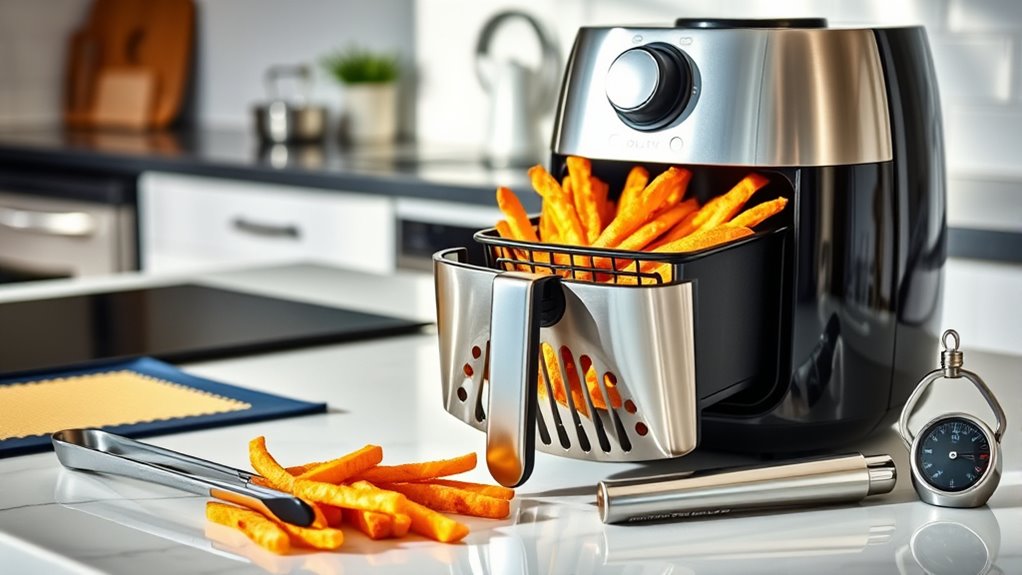
Choosing the right cookware and accessories is essential for successful air frying. Make sure your cookware is compatible with your air fryer and use accessories designed for high heat. Always select non-toxic materials to keep your food safe and free from harmful chemicals. Additionally, incorporating multi-functional furniture in your kitchen can optimize your space and improve your cooking experience. Proper air fryer maintenance can extend the lifespan of your appliance, ensuring consistent results. Regular cleaning helps prevent buildup of grease and food residues, which can affect performance and hygiene. To maintain your air fryer’s performance, be aware of air purifier maintenance dos and don’ts that can help ensure your appliance stays clean and efficient.
Compatible Cookware Selection
Selecting the right cookware and accessories is essential for successful air frying, as not all materials can withstand the high heat or promote even cooking. You want cookware that heats evenly and resists warping. Look for items made of metal, ceramic, or silicone, which handle high temperatures well. Avoid flimsy or non-stick pans that may degrade or release harmful chemicals. Consider the size and shape of your air fryer basket to ensure proper airflow. Additionally, use accessories that are dishwasher safe and easy to clean. Proper cookware helps prevent uneven cooking and sticking, ensuring your recipes turn out perfect every time. Regularly inspecting your cookware and accessories for wear and tear can help maintain safety and performance. Selecting cookware with high heat resistance ensures durability and safety during cooking. Being aware of material compatibility can further optimize your air frying results and prolong the lifespan of your cookware.
Proper Accessory Use
Using the right cookware and accessories is essential for safe and effective air frying. Choose accessories that are oven-safe and BPA-free, ensuring they can withstand high temperatures. Use a perforated or mesh basket when possible, as it promotes better airflow and even cooking. Avoid overcrowding your air fryer with bulky or improper items, which can block airflow and lead to uneven results. Silicone mats or parchment paper liners can help prevent sticking and make cleanup easier, but always check that they’re heat-resistant and fit well without obstructing the fan. Use tongs or heat-resistant gloves when handling hot accessories to prevent burns. Proper accessory use not only improves your cooking results but also extends your air fryer’s lifespan.
Non-Toxic Materials
To guarantee safe air frying, it’s important to use cookware and accessories made from non-toxic materials that won’t leach harmful chemicals into your food. Choose items labeled as BPA-free, PTFE-free, and free from harmful dyes or coatings. Opt for stainless steel, cast iron, ceramic, or silicone, which are safe and durable options. Avoid non-stick pans with synthetic coatings that can degrade over time. Always check for food-grade labels to ensure safety. Using the right materials helps preserve your health while maintaining the quality of your dishes. Properly selecting non-toxic cookware minimizes chemical exposure and keeps your air-fried meals wholesome. Prioritize quality, safety, and durability to enjoy delicious, worry-free recipes every time.
Monitor and Test for Doneness

Monitoring and testing for doneness is essential to guarantee your air-fried dishes come out perfectly cooked. Since air fryers cook quickly and evenly, it’s important to check your food early and often. Use a meat thermometer to ensure meats reach the safe internal temperature—160°F for ground beef, 165°F for poultry. For other foods, look for visual cues like bubbling, browning, or crispy textures. When testing baked items, insert a toothpick or skewer; if it comes out clean, your dish is ready. Don’t rely solely on time; every air fryer varies. Keep an eye on your food’s progress, adjust cooking times if needed, and remember that residual heat continues to cook food once removed. This approach prevents overcooking and guarantees a delicious, safe result.
Tweak Seasonings and Breading for Air Frying
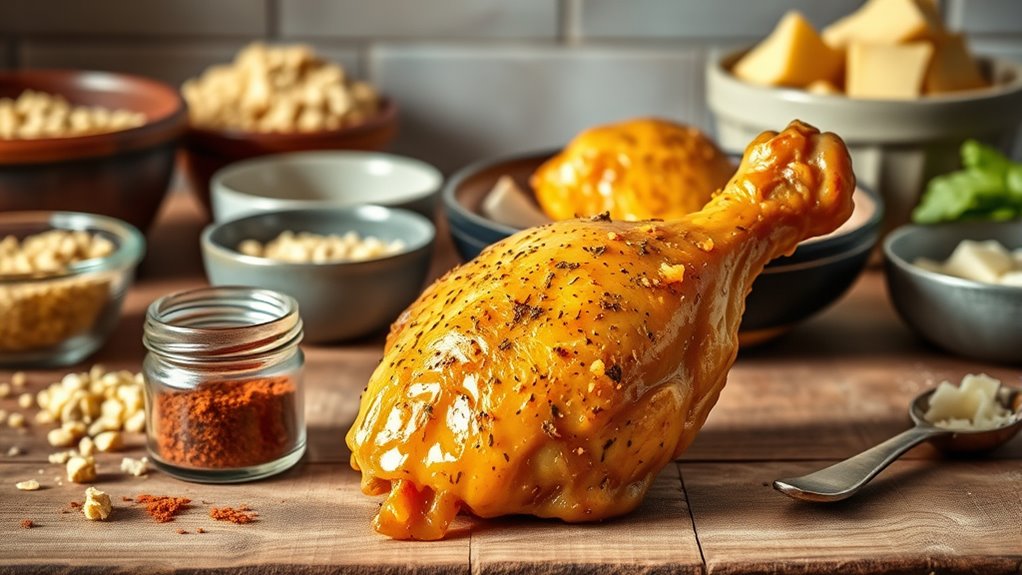
Adjusting seasonings and breading is key to achieving the best results when air frying. Since air fryers cook quickly and evenly, you might need to modify your usual coatings and spice blends. To enhance flavor and texture, consider these tips:
- Use lighter coatings like panko or crushed crackers to prevent sogginess.
- Reduce salt slightly, as intensities can amplify in the rapid cooking process.
- Incorporate moisture in breadings with egg wash or buttermilk to help seasonings stick.
- Experiment with bold spices or herbs to compensate for the quicker cooking, which might mute delicate flavors.
Practice Batch Cooking and Space Management
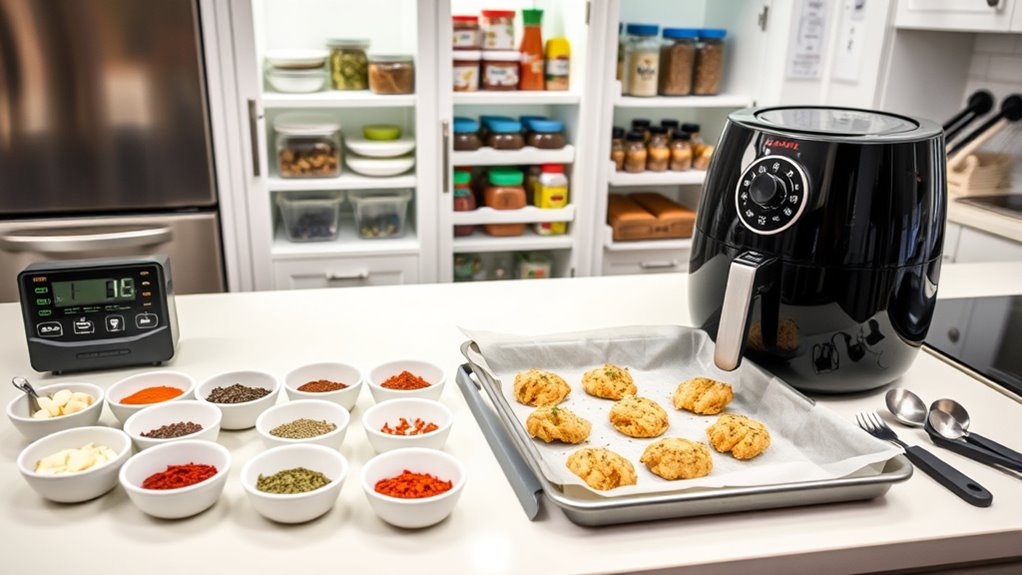
Practicing batch cooking and managing space effectively guarantees that your air frying sessions run smoothly and efficiently. When you prepare multiple servings at once, you save time and reduce the need for repeated cooking. Arrange your ingredients in a way that allows hot air to circulate freely around each piece, ensuring even cooking. Use multiple racks or trays if your air fryer supports them, and don’t overcrowd the basket. Rotate or shake items halfway through to promote uniform crispiness. Keep a close eye on cooking times, especially when cooking in batches, since some foods may cook faster or slower depending on how crowded the basket is. With good space management, you’ll maximize your air fryer’s capacity and consistently achieve delicious results.
Experiment and Refine Your Air Frying Technique

Once you’ve mastered batch cooking and space management, it’s time to experiment with different techniques to perfect your air frying skills. Try adjusting temperature and time settings for different recipes, as slight changes can dramatically improve results. Rotate or shake food halfway through cooking to ensure even crispiness. Use a light spray of oil to enhance browning without excess. Pay attention to airflow and avoid overcrowding the basket, which can hinder crisping.
Experiment with temperature, time, and shaking for perfectly crispy air-fried dishes.
- Test different temperature and time combinations for ideal results
- Shake or flip food during cooking for even browning
- Use minimal oil to improve texture without greasiness
- Adjust layering to prevent overcrowding and promote airflow
Frequently Asked Questions
Can I Convert Any Recipe for Air Frying Without Adjustments?
You can’t convert any recipe for air frying without adjustments because different foods need different temperatures and cooking times. Air fryers cook faster and more evenly, so you’ll need to tweak your recipe’s temperature and duration. Start with a lower temperature and check frequently. Adjust seasonings and coating as needed. With some experimentation, you’ll find the right method to make your favorite recipes perfect for air frying.
How Do I Handle Recipes With Sauces or Batters in the Air Fryer?
When handling recipes with sauces or batters in the air fryer, you need to be careful. Use a spray or brush to lightly coat foods with sauces before air frying, avoiding excess to prevent dripping and smoking. For batters, opt for thicker mixes and consider using a parchment paper liner or a wire rack to keep the coating intact. Always monitor to prevent messes and guarantee even cooking.
Are There Specific Ingredients That Don’T Work Well in Air Frying?
Imagine trying to fry a delicate soufflé or a gooey cheese sauce in your air fryer—it’s like expecting a snowstorm in summer! Certain ingredients, like wet batters, soft cheeses, and very sticky sauces, just don’t hold up well. They can cause messes or even damage your appliance. Stick to sturdier ingredients like breaded items, vegetables, and firm cheeses for the best air frying results.
How Do I Prevent Food From Sticking or Burning in the Air Fryer?
To prevent food from sticking or burning in your air fryer, always preheat it before cooking. Lightly spray or brush food with oil to reduce sticking and promote even browning. Avoid overcrowding the basket to guarantee proper air circulation. Check your food frequently during cooking, and shake or turn items halfway through. These steps help you achieve crispy, evenly cooked results without sticking or burning.
What’s the Best Way to Clean and Maintain My Air Fryer After Cooking?
Imagine the warm glow of a clean air fryer, ready for your next meal. To keep it spotless, unplug it and let it cool. Remove the basket and tray, then wash them with warm, soapy water, using a soft sponge. Wipe the interior with a damp cloth—avoid abrasive cleaners. Regular maintenance guarantees your air fryer functions effectively, making every crispy bite as delicious as the first.
Conclusion
With a little bit of boldness and a dash of daring, you can effortlessly adapt your favorite recipes for air frying. Embrace experimentation, adjust your approach, and enjoy crispy, delicious creations every time. Remember, practice paves the path to perfection, so don’t hesitate to tweak and test. With patience and persistence, you’ll perfect your process and turn everyday dishes into extraordinary eats — all with your trusty air fryer by your side!
